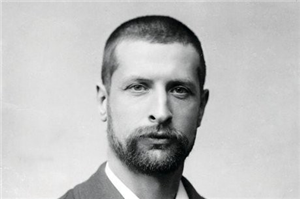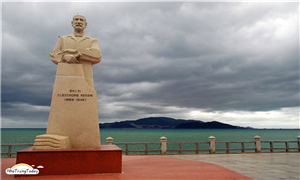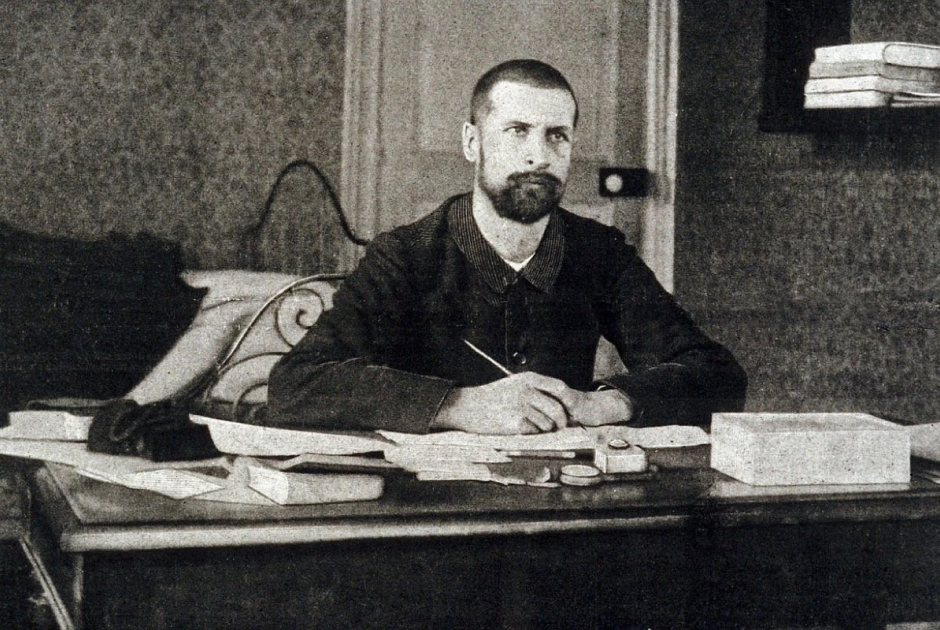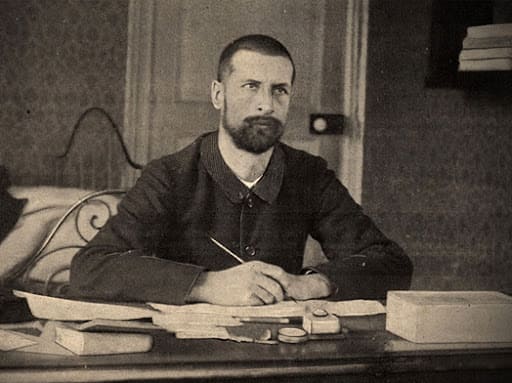* Alexandre Yersin:
Alexandre Yersin, a renowned French scientist (1863 – 1943), is one of the French figures well-known among the Vietnamese. Yersin served as the Director of the Pasteur Institute in Indochina. He was also the founder and the first Dean of the Hanoi Medical University. Additionally, Dr. Alexandre Yersin was an explorer, an agronomist, and a world-famous scientist in bacteriology. Although of Swiss-French origin, he spent the majority of his life in Vietnam and considered Vietnam his second homeland. While many know Alexandre Yersin as a renowned scientist, few are aware of his Protestant faith, and fewer still know the primary motivation that led him to Vietnam.
According to Professor Doan Xuan Muu, former Director of the Pasteur Institute in Dalat and someone closely associated with Alexandre Yersin, Yersin was a devout Protestant with deep-rooted beliefs. Following the massacre of Huguenots, French Protestants, in 1572, Emperor Henry IV issued an edict allowing Protestants limited worship rights in France (Edict of Nantes – 1598). However, in 1685, King Louis XIV revoked this edict, issuing a new one known as the Edict of Fontainebleau. Louis XIV’s decree placed Protestants outside the legal framework, giving French Protestant believers two choices: either renounce their Protestant faith and return to Catholicism or leave France. Faced with this situation, Yersin’s ancestors sought refuge in Switzerland. Yersin himself was the eighth generation descendant of these Huguenot Protestants. Scholar Thai Van Kiem, former Governor of Khanh Hoa province, confirmed these details in his article “The Life and Career of Dr. Alexandre Yersin (1863 – 1943).”
1. Biography
Alexandre Yersin was born on September 22, 1863, in Lavaux, a small village in the Vaud district of Switzerland. In the first half of the 19th century, Protestant missionaries in China often called on educated young men to participate in medical missionary work. Responding to this call, after graduating from high school, Yersin pursued medical studies at the University of Lausanne for one year (1883-1884). In 1884, Yersin went to Germany to study medicine at the University of Marburg. This was the oldest university founded by Protestants in 1527 and was a prestigious medical university in Germany. Here, Yersin studied under Emil Adolf von Behring, who later won the first Nobel Prize in Physiology or Medicine in 1901. After some time, Alexandre Yersin moved to Paris (1885 – 1888) for his internship.
In 1886, Yersin met Louis Pasteur, the most famous bacteriologist in the world at the time. Admiring Pasteur’s talent, Yersin joined Pasteur’s laboratory at the École Normale Supérieure as a technical assistant to have the opportunity to conduct research. Here, Yersin became the assistant of Emile Roux, a trusted student of Pasteur. In 1888, Yersin completed his doctoral thesis on the “Study of Experimental Tubercle Development.” Although Yersin’s thesis was short, only about 20 pages with 6 illustrations, it contained new and significant discoveries in the field of medicine, earning him the title of Professor from the Faculty of Medicine in Paris in 1889. During the waiting period for his thesis defense, Alexandre Yersin collaborated with Emile Roux’s research group on anthrax toxins. Alexandre Yersin and Emile Roux went to Germany for a few months, pioneering research in bacteriology at that time. As mentioned earlier, the professor who taught him in this field later received the Nobel Prize in Medicine, Emil Adolf von Behring (Nobel 1901).
Louis Pasteur and Emile Roux admired Yersin’s determination, character, and talent. These two scientists wanted to invite Yersin to conduct long-term research, so they advised Yersin to naturalize as a French citizen to be allowed to stay and work in France. Yersin followed the advice of his sponsors. Yersin became a French citizen in 1888, but he had a broader purpose in mind. More than a year after Alexandre Yersin graduated, on November 14, 1889, the Pasteur Institute in Paris was inaugurated. Yersin was invited to work here as a collaborator of Emile Roux. Besides research, Alexandre Yersin also had the responsibility of teaching microbiology to students. Emile Roux and Alexandre Yersin were the first to compile a microbiology textbook and teach the subject at the university level worldwide.
2. Motivation for Coming to Indochina
At the young age of 26, having graduated with a medical degree, being invited to work in a prestigious medical research institute, in a glamorous city at that time, with a promising future laid out for a young scientist, Alexandre Yersin did not stop there. He followed a higher calling. Since childhood, Alexandre Yersin had admired David Livingstone (1813 – 1873), a British medical doctor and a Protestant missionary. David Livingstone was one of those who fervently responded to missionary work through medical means. In response to a call from Reverend Charles Gützlaff, a Protestant missionary in China, David Livingstone convinced his father to allow him to study medicine and then volunteer to spread the gospel through medical work in China. Unfortunately, after David Livingstone graduated, the First Opium War broke out in China. Due to the unrest in China, the London Missionary Society decided to send Livingstone to Africa.
When David Livingstone arrived in Africa, alongside his role as a medical missionary, he became an explorer. He undertook numerous journeys across Africa, discovering the source of the Nile River and helping the world understand the beauty and richness of Africa. After gaining fame, David Livingstone used his influence to advocate for the abolition of slavery, the reform of feudal and colonial systems, and the promotion of commerce. To change the perception of Africa, then referred to as the “Dark Continent,” from a state of wilderness, David Livingstone operated under the principle of the three Cs: “Christianity, Commerce, and Civilization.”
Following in the footsteps of David Livingstone, Alexandre Yersin also studied medicine and awaited the opportunity to embark on missionary work. He kept his intention to become a missionary secret from friends and colleagues. In addition to his academic pursuits, Yersin spent much of his time researching maps of China and Indochina. The 19th century witnessed a flourishing of the Protestant missionary movement. Pioneering missionaries often called on European youth to dedicate their lives to spreading the love of God to distant nations. The revival movement within the Protestant community began in the 1730s in England with ministers such as John Wesley and George Whitefield. Over the next 150 years, Protestant missionaries operated in nearly every corner of the globe, yet there were still places with dense populations where Protestant missionaries had not set foot.
At the end of the 19th century, missionary journals often issued calls to action, stating that Sudan, Tibet, and Indochina were vast regions with dense populations but still lacked any Protestant missionaries. Alexandre Yersin and Albert Schweitzer – the Nobel Peace Prize laureate in 1952 – were among the Protestant doctors who responded to this call. Alexandre Yersin went to Indochina, and Albert Schweitzer went to Gabon, Africa. In addition to sharing the love of God with people living in remote areas, these individuals used their medical and scientific knowledge to improve the lives of those populations.
Having worked at the Pasteur Institute in Paris for less than a year, Alexandre Yersin resigned in September 1890 to board the Messageries Maritimes ship bound for Indochina. Not understanding Yersin’s deep motivation, his colleagues and friends were amazed when he gave up his research, teaching, and prestigious position at the famous Pasteur Institute in Paris to work as a ship’s doctor. After Yersin’s departure, Louis Pasteur wrote in his diary on October 21, 1890: “The impulse to go to distant countries suddenly attracted Yersin, and there was no way to keep him with us.”
As a French-born Protestant, Alexandre Yersin understood the difficulties that Protestant individuals faced living within French territory. Yersin understood why Protestant missionaries were not allowed to operate in Indochina at that time. Therefore, Yersin did not seek to become a missionary for the London Missionary Society or Paris, Protestant missionary organizations. Yersin only sought French citizenship like the Apostle Paul in the Bible, using Roman citizenship and his tent-making profession to travel from place to place to serve God. Thus, Alexandre Yersin came to Indochina as a French scientist rather than a pure Protestant missionary. In October 1890, Yersin arrived in Saigon, and in July 1891, on a ship from Saigon to Hai Phong, Yersin was captivated by the beauty of the Nha Trang coastline. Yersin chose this coastal town as his place of residence.
**3. Early Time in Vietnam**
Following David Livingstone’s example, a few months after arriving in Nha Trang, Yersin began his first exploration. Having traveled extensively along the Vietnamese coastline by sea, Yersin believed he would find an overland route from Nha Trang to Saigon. From Nha Trang, Yersin rode a horse to Phan Rí (Bình Thuận). From there, he hired an indigenous guide to help him cross the forest to the Central Highlands. In this expedition, Yersin planned to find a route to the upper reaches of the Dong Nai River and then follow it downstream to Saigon. The journey was about 500 kilometers long. After two arduous days, the guide led Yersin to Djiring (Di Linh), but he refused to continue due to the danger. Yersin had to return to Phan Thiet alone and then back to Nha Trang. Despite the failure, Yersin prepared for another expedition. In 1891, Albert Calmette, a student of Emile Roux, was sent to Indochina to establish a laboratory for the Pasteur Institute in Saigon. Knowing Alexandre Yersin was a talented individual, Louis Pasteur and Emile Roux instructed Albert Calmette to try to persuade Alexandre Yersin to return to research. Despite the advice of his colleagues, Alexandre Yersin accepted a position with the Colonial Health Service in Saigon. The relationship between Albert Calmette and Alexandre Yersin was formed from this collaboration. Yersin’s doctoral thesis studied the origins of tuberculosis. Later, Albert Calmette and Camille Guérin researched and developed the BCG vaccine against tuberculosis.
**4. Indochina Exploration**
Yersin’s motivation to come to Indochina did not escape the attention of the French authorities. Aware of Yersin’s capabilities, the French authorities in Indochina cleverly used him for their purposes. Governor-General of Indochina Jean Marie Antoine de Lanessan entrusted Yersin with leading three expeditions through the Vietnamese highlands. Later, the French authorities requested Yersin to perform other noble tasks beneficial to the French government and to keep him from having much time for missionary work. On March 29, 1892, the authorities in Indochina tasked Alexandre Yersin with his first expedition. As there was the Nile River in Africa, there was the Mekong River in Indochina. From Nha Trang, Yersin traveled to Ninh Hoa and then crossed the mountains to Pleiku (Gia Lai) and Kon Tum, continuing northwest to the Mekong River at Stung Treng in northern Cambodia. From there, Yersin hired a boat downstream to Phnom Penh on May 15, 1892. He then proceeded to Phu Quoc and returned to Saigon. The success of the first expedition led Governor-General Jean Marie Antoine de Lanessan to assign Yersin the responsibility of exploring the opening of a route from Saigon to the Central Highlands. In the second expedition, Yersin traveled by road from Bien Hoa to Dong Nai, then to Di Linh and onward to the Lam Vien Highlands (Lam Dong). In his diary on June 21, 1893, recording the journey, Yersin mentioned that there were several villages of the Lach ethnic group scattered in this area. “Emerging from the pine forest, I was astonished to face a vast plain resembling a sea full of green waves. The grandeur of the Lang Bian range blending into the northwest horizon creates a magnificent backdrop, enhancing the beauty of this land.”
In front of the beautiful landscape, with a mild climate, lakes, waterfalls, and pine forests, Yersin reminisced about his homeland in Switzerland. He thought that this would be an excellent place to build a resort city. He suggested to the French authorities in Indochina that they should do just that. Later, Governor-General Paul Doumer, in his efforts to develop the economy of Indochina, implemented Yersin’s suggestion. The land of the D’Lat people became the city of Dalat today. In the late 1930s, the French planned to develop Dalat into the new capital of Indochina. However, World War II broke out, and France lost control of Indochina, causing this project to be abandoned.
Many people wonder where the name “Dalat” originated from. Some believe it is an abbreviation of “Dat Aliis Laetitiam Aliis Temperem,” meaning “Bringing joy to some and health to others.” However, the name “Dalat” actually comes from the term “D’Lat” in Yersin’s diary. According to Reverend Pham Xuan Tin, a veteran Protestant missionary in the Central Highlands of Vietnam and a linguist who created writing systems for ethnic minorities, “Da” means “land,” and “Lat” refers to the Lach people (a branch of the Co Ho ethnic group). Therefore, “Da Lat” means the land of the Lach people. Later, the Vietnamese adapted it to “Dalat.” The Latin phrase was coined by Europeans from the name “Dalat” when they experienced the benefits of this city. Another name with a similar origin is “Dran” or “Don Duong,” a small town in Lam Dong province, and “D’Ran” or “Da Ran,” a small river in Di Linh.
At the end of 1893, Yersin embarked on his third expedition along the Truong Son Highlands. From Bien Hoa to Dalat, Yersin continued to the Dak Lak Highlands, then to Attapeu province in southern Laos. From there, he headed east towards the sea. Yersin arrived in Danang on May 17, 1894. This third survey explored a vast area stretching from the 11th parallel in the south to the 16th parallel in the north, and from the Mekong River in the west to the Vietnamese coastline in the east.
**5. Contributions to Global Medicine**
Yersin prepared for his fourth expedition, intending to study the high mountains in Cao Bang, Lang Son, through the provinces of Guangdong and Yunnan in China to reach the upper reaches of the Mekong River. However, this fourth survey had to be aborted because in 1894, a bubonic plague outbreak occurred in Guangdong, killing about 60,000 people. Subsequently, the plague spread to Hong Kong and posed a risk of spreading to Indochina. The death rate of the 1894 epidemic was very high: 95% of infected people died. Faced with this situation, the French authorities sent Yersin to Hong Kong to research and find ways to help.
Yersin left Saigon for Haiphong on June 2, 1894, from where he boarded a ship to Hong Kong. Upon arrival, nearly half of Hong Kong’s population had evacuated. Yersin set up a field laboratory in Hong Kong and focused on researching the origin of the plague. With his expertise in bacteriology, within just one week, on June 20, 1894, Yersin discovered the plague bacillus. Subsequently, scientists named the bacterium Yersinia pestis, after Yersin. Yersin was the first to demonstrate that this bacterium could live in rats and could be transmitted to humans. The origin of the plague, which had killed hundreds of millions of people worldwide over thousands of years, was discovered by Yersin. Discovering the plague bacterium brought Yersin fame, however, the important thing for him was not just finding the pathogen but finding a cure. As a sensitive and compassionate person, witnessing tens of thousands of people die from the plague that year, in 1895 Alexandre Yersin set aside other plans and returned to the Pasteur Institute in Paris to collaborate with Émile Roux, Albert Calmette, and Amédée Borrel to develop serum therapy for the plague. After completing the research, a few months later, Yersin returned to Nha Trang to establish a laboratory to produce serum in Indochina. Yersin believed that if Indochina could produce enough serum in large quantities, it would greatly assist in treating outbreaks in China, as the medicine could reach patients within a few days, whereas if shipped from France, it would take months, and patients would not survive during that time. Along with Albert Calmette’s laboratory in Saigon, the research facility in Nha Trang was the precursor to the Pasteur Institute of Indochina.
To produce serum for medicine, a large amount of blood was needed. With his established reputation, Yersin requested land from the Indochinese authorities to establish a horse breeding farm for this purpose. In 1896, the Indochinese authorities granted Yersin the Suoi Dau farm. Three years later (1899), the French Consul General in Central Vietnam granted Yersin an additional 500 hectares of land in Khanh Hiep near Dien Khanh (Khanh Hoa). The serum produced from these horse breeding farms helped save hundreds of people with plague in India and China in the following years.
Alexandre Yersin in Amsterdam – the Netherlands







